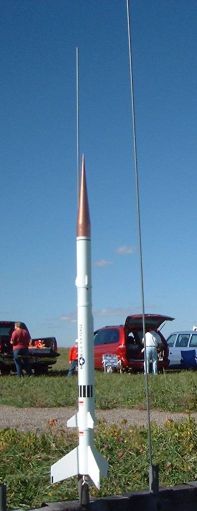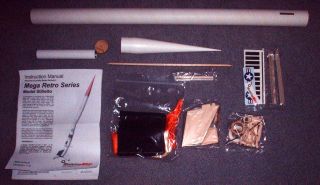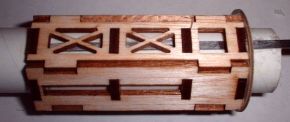| Construction Rating: | starstarstarstarstar |
| Flight Rating: | starstarstarstarstar_border |
| Overall Rating: | starstarstarstarstar_border |
| Manufacturer: | Qmodeling  |

Brief:
If a rocket can be sexy, this one is it. A long, sleek upscale of the Estes
kit, this is a beautiful single stage 24mm rocket that flies as well as it
looks.
Construction:
I had purchased this kit through pre-order, which took several weeks but normal
purchases will arrive quickly and carefully packaged in a Priority Mail tube.
The kit is packed in a sealed plastic bag with components checked off by hand
on the header card.
The components for this kit are very good quality and include:
- resin cast nose cone
- BT-60 body tube
- 9 laser cut balsa fins
- Balsa raceway
- 24mm foil lined motor tube
- Centering ring/motor mount kit
- 30" Top Flight nylon chute
- 9' x 9" Nomex® heat shield
- Kevlar® recovery line
- External trim rings
- Waterslide decals
- 3/16" launch lug
Note: The nose cone is the same as the one used for their Rogue and WAC Corporal kits. By leveraging the cone across multiple kits, they were able to invest more money in a better quality mold and it shows on the finish of this cone! It is one of the nicest poured cones I have ever seen.

I found the instructions to be easy to work with and well illustrated. The instructions are broken into subsections, each with time estimates so you can plan your assembly project accordingly. For the experienced builder, this is probably a 2 afternoon project over a weekend plus time for finishing. Overall, I'd rate it a skill level 3 on the old Estes 1 to 5 scale.
Construction begins with the motor mount assembly. This kit comes with a foil lined motor tube, which should be more durable than the typical paper tubes of most kits. Rather than a basic centering ring approach though, there's a fairly elaborate assembly of laser cut balsa braces that enable through-the-wall fin support. The balsa braces are fairly delicate by themselves but once assembled are actually quite durable. Everything fit together well but lining everything up for the through-wall mounting is tricky and the instructions warn to tack things together and check for fit before the final glue job. The assembly is finished off by attaching the Kevlar® shock cord to the end of the motor mount through the centering ring.
 All of the
fins are precut so there's no hand cutting necessary. Instead, you might want
to apply your time to filling and sanding them, as the grain is fairly rough
and a polished, grain free appearance is worth it for this rocket. The
instructions suggest a couple of coats of sanding sealer, but I prefer diluted
Elmer's Fill 'n' Finish since it is fume free.
All of the
fins are precut so there's no hand cutting necessary. Instead, you might want
to apply your time to filling and sanding them, as the grain is fairly rough
and a polished, grain free appearance is worth it for this rocket. The
instructions suggest a couple of coats of sanding sealer, but I prefer diluted
Elmer's Fill 'n' Finish since it is fume free.
The body tube was pre-slotted and needs a few marks before the assembly phase. The lower fin position is obvious (through the slots), but there are two other sets of fins mounted in alignment with the lower fins, plus 3 "separation rings" for trim. My instructions were among the first released and contained several errors in marking dimensions/locations, but before I had gotten around to building this, QModelling sent out a notice alerting me to the problems and offering the correct dimensions. I've noticed similar problems on a couple of their other kits and would generally warn folks to avoid being one of the first ones to build a new release, unless you're very careful and read the entire set of instructions (including paint schemes) first.
The separation rings are actually just cardboard strips wrapped around the outside of the body tube: a shorter inner strip and a longer outer strip. If you're careful, they look about as decent as a centering ring. If you're really anal retentive, you could fill the sides with putty for a smooth finish.
Tacking on and aligning the fins, raceway strip, and launch lug/standoff takes a bit of time but isn't terribly difficult. The instructions, which include fairly precise dimensions, are very helpful here.
While I gushed earlier about the nose cone, I will admit that it does take a little bit of work. There's a faint parting line that needs to be shaved or sanded down. I used the edge of a razor blade perpendicular to the cone surface. It also uses a wood disk and screw eye for retention. The disk fits snugly inside the cone and when reinforced with a fillet of CA provides a surprisingly sturdy anchor point for the Kevlar® shock cord.
Finishing:
As mentioned earlier, filling and finishing the balsa grain is a real must for
this kit. In addition, the faint tube spirals should be filled with Elmer's
Fill 'n' Finish as well. This is simply too pretty a design to leave to a
halfhearted finish job.
After filling seams and spirals, I applied three light coats of gray/gray/white primer, sanding between each. After the 3rd coat, I also lightly sanded everything using a wet 600 grit paper. I then finished up with two coats of glossy white. There are probably some wonderful accent color schemes you could apply to this, but I was drawn to the simplicity of the standard all white paint job with copper for the nose and upper portion of the tube. Still, anyone wanting to mask off the fins and/or separation rings could pull off some interesting schemes.
The final touches are the application of waterslide decals. The quality and workability of the decals gets better and better with each new QModeling release, and these decals were very easy to apply and rearrange as needed. There are plenty of illustrations assisting in placement/orientation.
Construction Rating: 5 out of 5
Flight:
I went easy on this for the first flight as the wind conditions and pad
location for our club launch had us fairly limited in landing area. I opted for
the D12-3 and set her up in 7-8 mph winds. There was a noticeable weathercock
but not too severe. The 3 second delay was slightly before apogee but not
enough to warrant going to a 5. Cursed by the protection afforded by the
30" nylon chute, this rocket came down very slowly and wound up clearing
the park and landed in a neighboring subdivision, dragging my pretty nose cone
along the pavement for about a hundred yards. The paint job was scuffed pretty
badly but is easy to touch up.
Overall, it was a very good flight and moving up to an E or F is going to send this one out of sight.
Recovery:
The recovery package for this kit is both a pro and a con. The Nomex®
heat shield, Top Flight 30" orange nylon chute, and Kevlar®
shock cord are the best package you'll find in any modroc. Unfortunately, it
looks like QModelling got a package deal on them for their larger kits and are
kind of shoving these into the smaller kits. The 9" x 9" Nomex®,
at roughly 5 times the body tube diameter, is too large to fit in the BT-60
without risking an overpacked tube and non deployment. The 30" chute is
wonderful but way too much for a rocket that should weigh in under 9 ounces. I
love the quality of these but am going to stash them in my range box for larger
birds and using a 20" nylon chute for this one going forward.
Flight Rating: 4 out of 5
Summary:
I absolutely love the design of this rocket. It looks and flies great, and
QModeling has done a great job of putting together a top quality upscale. If
they could downsize the recovery a bit (and hopefully trim a few dollars off
the price), it would get a perfect score.
Overall Rating: 4 out of 5
Other Reviews
- Qmodeling Stiletto By Dick Stafford
Brief: This is one of QModeling's Mega Retro Series (MRS) kits. It's a 1.68:1 upscale of the classic Estes kit and flies on 24mm motors. It is a great looking kit and the parts are exceptional quality. Construction: The kit came nicely packaged with most small components in their own bags (e.g. all motor mount components bagged together). It appears that some of the components ...
 |
 |
Flights
 |
 |
Sponsored Ads
 |
 |












M.E.R. (April 14, 2008)